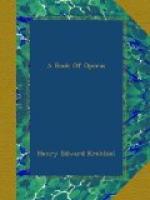The initiation of Tamino and Papageno into the mysteries, their trials, failures, triumph, and reward, form the contents of the second act. At a conclave of the elect, Sarastro announces that Tamino stands at the door of the Temple of Wisdom, desirous to gaze upon the “great light” of the sanctuary. He prays Isis and Osiris to give strength to the neophytes:—
[Musical excerpt—“O Isis und Osiris schenket Der Weisheit Geist dem neuen Paar.”]
To the impressiveness of this prayer the orchestra contributes as potent a factor as the stately melody or the solemn harmonies. All the bright-voiced instruments are excluded, and the music assigned to three groups of sombre color, composed, respectively, (1) of divided violas and violoncellos; (2) of three trombones, and (3) of two basset horns and two bassoons. The assent of the sacerdotal assembly is indicated by the three trumpet blasts which have been described in connection with the overture, and Tamino and Papageno are admitted to the Temple, instructed, and begin their probationary trials. True to the notion of the order, two priests warn the neophytes against the wiles of woman. Papageno has little inclination to seek wisdom, but enters upon the trials in the hope of winning a wife who shall be like himself in appearance. In the first trial, which is that of silence, the value of the priestly warning just received is at once made apparent. Tamino and Papageno have scarcely been left alone, when the three female attendants of the Queen of Night appear and attempt to terrify them with tales of the false nature of the priests, whose recruits, say they, are carried to hell, body and breeches (literally “mit Haut und Haar,” i.e. “with skin and hair"). Papageno becomes terror-stricken and falls to the floor, when voices within proclaim that the sanctity of the temple has been profaned by woman’s presence. The ladies flee.




